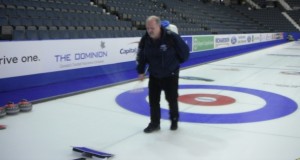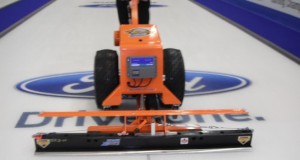Making Great Ice: Experimenting with pebbling and scraping
Here we are in November already, and the season is rolling along. What I tell you next will vary from club to club. You will have to experiment and see what works best for your club.
First, pebbling.
Water is one of the most important aspects of pebbling, and good water quality is very important. Reverse osmosis and de-ionized water are two of the best. With these you should have a PH of 5 to 6. Going higher makes the water more alkaline, and lower will be more acidic.
Also you will want to control the dissolved solids in the water with a filter. Getting your parts per million (or ppms) down below 10 will greatly improve your water quality.
Next, pebble heads. They come in many different sizes and shapes. For a gravity-fed back pack you can get sizes from 77, which has the smallest holes, up to 70, which is the largest holes. With this you can get a variation of holes on the head, each having a different application to suit your situation. Having said all this, it is important to keep a number of different head sizes available to you for experimenting and finding which one works best.
Next, water temperature. Temperature plays a key role in how your pebble stands up and lasts. Again, this is a trial and error situation to see which works best for you. The guidelines I use when starting off in a club is a base at 90 degrees F with a 76 pebble head, and my top will be 120 degrees F with a 75 pebble head. Remember this is just a starting point. It may not give you your best results so try different variations to see what works best. Only change one thing at a time so you know if that change makes a difference. If you make too many changes at once, you won’t know which one worked or didn’t work.
Scraping is another key element to providing good ice for your curling club members. One of the most asked questions is how often should we scrape. Here is my rule of thumb: scrape every day or every three draws. Let me explain. If you have four or more draws a day, fit in time to scrape in the morning before the first draw and middle of the day between your second and third draw, or between your third and fourth draw, depending on how many you have. Your ice quality will greatly improve by keeping the pebble build-up down. If you only have one or two draws a day, scrape every day before those draws. The curlers will be excited to see how the ice improves.
The key to consistent ice is good scraping and pebbling. When you scrape, make sure that you do the same pattern on one side of the sheet as you did to the other. Also make sure you vary your patterns so that you do not put a run in the ice from scraping the same pattern. It is important to have three or four different patterns. Also, scraping all the sheets the same way every time will help you read the ice. If you develop a run in the same spot on every sheet, this usually means that you have a blade issue. That is why it is very important to have at least two blades and even more for the busier clubs. Also, make sure you use a reputable sharpening company. Check around and see who uses which company and if they are happy with the product.
The biggest problem I see when I visit a club is not the scraping patterns they use (because these will vary from club to club and one way will work for one place and not at yours). No, the biggest scraping problem is that icemakers are afraid to scrape aggressively. I like to pebble the sheet before I scrape, then scrape it down to flat, to the point where hardly any old pebble is visible. Remember you can scrape so far and then nothing else will come off.
Keep your blade sharp and your water pure. Good luck!






